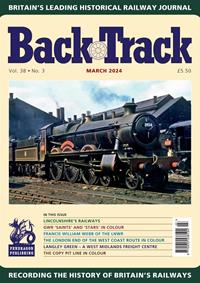|
|
Contents Listing - Articles & Features in this issue
Scottish Rambling
Rails to Morecambe
The Upgrading of God's Wonderful Railway
Southern Six-Coupled Tanks
'The Nearest Run Thing' - Marylebone Station and its Suburban Services - Part Two
Signalled through Barnetby and WrawbyJunction
The Railway in Court: Mind the Gap
Cheltenham and Gloucester
The Smithy Wood Branch
Banavie
To Crewe for Repairs
A Different Class - The LNER Bl7s
Tales from a South Wales Footplate
Readers' Forum
Book Reviews
Article Snippets
Reform and rehabilitation:
This month we conclude our look at the chequered history of Marylebone station in London. The 'last main line' arrived in the capital with upbeat visions of rollicking times ahead and the Great Central Railway (as it became) provided itself with a new terminus modest in size but with land for expansion as the anticipated growing traffic demanded. It never did, of course; the GC's main line gradually declined in status until most of it closed in 1966, leaving behind Marylebone, semi-conscious, as home only to suburban diesel trains, a London terminal where (as Alan Jackson wrote in 1969) "the twittering of birds in the roof is heard" and which "seems unlikely to last much longer".
It did cling on but by the 1980s its future really was seriously threatened so while in London one day, with a little time to fill before my train home, I went to visit it, partly because I'd never been there, partly because it might disappear before I had any reason to use it. There was certainly about the place a 'time has not moved on' air but even so on peering over the Rossmore Road bridge I was surprised to find a large locomotive turntable still there. Interesting, I thought...
In 1985 steam made a return to Marylebone, tentatively at first but with some cautious British Rail encouragement. The station's relative quietness, not to mention the convenient survival of that turntable, gave it an advantage for such operations that other busier London termini lacked and before long a series of dining car excursions to Stratford-upon-Avon had become a regular and popular Sunday event.
During that summer the National Railway Museum sent Duchess of Hamilton to participate in these workings, followed in subsequent years by Mallard and Green Arrow, and as part of the support crews I spent some time at Marylebone. To say the station was run-down by then would be putting it mildly, while the diesel depot at which we were based had not seen any investment in its facilities since it was built; a lingering memory is of the mound of used teabags emptied out of the messroom window, which alternately dried out in the sun but was then reactivated in the rain to run as as a thin brownish seepage! On the old loading dock where the engines were prepared there was a rubbish skip in which intermittently dwelt a tramp whowould emerge from underthe cardboard boxes to remonstrate with us if we were a bit too boisterous when returning at night after a few pints. However, the enthusiasm of the staff and enginemen couldn't have been bettered - some cracking locomotive performances were recorded - and those activities must have been a great morale-booster for them at a time when their station and its train services were in desperate need of the spotlight of some favourable publicity.
Well, that was then and here we are 30 years on - Marylebone has not only pulled through but been completely refurbished, with more platforms just as its creators had envisaged; there are modern trains and more passengers than ever. The former Great Western/Great Central joint line, extensively singled during the 'rationalisation' era, has been restored to double track and services now extend to Birmingham and beyond.
Inevitably, given the way railway history has played out since the 1960s, many of the 'geographical' narratives in this magazine end in failure: train services withdrawn, lines and stations closed, sites taken over by housing estates, supermarkets and retail parks, or submerged beneath road improvement schemes.That makes it all the more uplifting to read of the transformation of Marylebone's fortunes from its doldrum years: maybe not as spectacular as that of St. Pancras across the city, but nonetheless significant in its own way.
It's become the way of it in certain political quarters to attribute the growth of rail travel in recent times to the indisputable wonder of privatisation. We should therefore not refrain from noting that the revival of Marylebone and what developed into the 'Chiltern Line' was initiated by British Rail and driven forward under its then new 'sector' management. A point worth remembering...Recent railway journeys haven't always been that satisfactory, so it is pleasing to report that one in February between York and Birmingham proved rather enjoyable. I ventured online into the world of split ticketing which resulted in the journey being booked in three stages and yielding no fewer than ten tickets and seat reservations. On the other hand a saving of £17 meant I could indulge in a first class seat for a spot of unashamed hedonism (or what passes for it on today's railway): an adjustable seat to myself and all the free comestibles on offer - plenty of tea (from a pot!), a breakfast wrap, shortbread biscuits - and a tranquil environment. But as I spread out my tickets on the table like a card sharp challenging the conductor to find the Derby to Sheffield one, it did occur to me that paying for a train journey at the most advantageous fare really ought not to be as convoluted as this...
And so to Birmingham New Street for the first time since its 'rebirth'. Well, the platforms in the underworld are much the same, dark and claustrophobic, but up the stairs and escalators the world now presented to the traveller is very different - glossy, modern and behold, light is shone upon the scene from the sky. Much opprobrium has been heaped on New Street since the 1960s happened to it - justifiably so - but it's never too late to repent on past sins and whilst the actual train-handling area is probably as good as it's going to be, the long-awaited response to the 'something must be done about it' consensus on the rest of the station is to be applauded. So, with St. Pancras, Marylebone, New Street and even Wakefield Kirkgate rehabilitated to render them fit for polite society, what next? Well, there's still Euston, of course...
This month we conclude our look at the chequered history of Marylebone station in London. The 'last main line' arrived in the capital with upbeat visions of rollicking times ahead and the Great Central Railway (as it became) provided itself with a new terminus modest in size but with land for expansion as the anticipated growing traffic demanded. It never did, of course; the GC's main line gradually declined in status until most of it closed in 1966, leaving behind Marylebone, semi-conscious, as home only to suburban diesel trains, a London terminal where (as Alan Jackson wrote in 1969) "the twittering of birds in the roof is heard" and which "seems unlikely to last much longer".
It did cling on but by the 1980s its future really was seriously threatened so while in London one day, with a little time to fill before my train home, I went to visit it, partly because I'd never been there, partly because it might disappear before I had any reason to use it. There was certainly about the place a 'time has not moved on' air but even so on peering over the Rossmore Road bridge I was surprised to find a large locomotive turntable still there. Interesting, I thought...
In 1985 steam made a return to Marylebone, tentatively at first but with some cautious British Rail encouragement. The station's relative quietness, not to mention the convenient survival of that turntable, gave it an advantage for such operations that other busier London termini lacked and before long a series of dining car excursions to Stratford-upon-Avon had become a regular and popular Sunday event.
During that summer the National Railway Museum sent Duchess of Hamilton to participate in these workings, followed in subsequent years by Mallard and Green Arrow, and as part of the support crews I spent some time at Marylebone. To say the station was run-down by then would be putting it mildly, while the diesel depot at which we were based had not seen any investment in its facilities since it was built; a lingering memory is of the mound of used teabags emptied out of the messroom window, which alternately dried out in the sun but was then reactivated in the rain to run as as a thin brownish seepage! On the old loading dock where the engines were prepared there was a rubbish skip in which intermittently dwelt a tramp whowould emerge from underthe cardboard boxes to remonstrate with us if we were a bit too boisterous when returning at night after a few pints. However, the enthusiasm of the staff and enginemen couldn't have been bettered - some cracking locomotive performances were recorded - and those activities must have been a great morale-booster for them at a time when their station and its train services were in desperate need of the spotlight of some favourable publicity.
Well, that was then and here we are 30 years on - Marylebone has not only pulled through but been completely refurbished, with more platforms just as its creators had envisaged; there are modern trains and more passengers than ever. The former Great Western/Great Central joint line, extensively singled during the 'rationalisation' era, has been restored to double track and services now extend to Birmingham and beyond.
Inevitably, given the way railway history has played out since the 1960s, many of the 'geographical' narratives in this magazine end in failure: train services withdrawn, lines and stations closed, sites taken over by housing estates, supermarkets and retail parks, or submerged beneath road improvement schemes.That makes it all the more uplifting to read of the transformation of Marylebone's fortunes from its doldrum years: maybe not as spectacular as that of St. Pancras across the city, but nonetheless significant in its own way.
It's become the way of it in certain political quarters to attribute the growth of rail travel in recent times to the indisputable wonder of privatisation. We should therefore not refrain from noting that the revival of Marylebone and what developed into the 'Chiltern Line' was initiated by British Rail and driven forward under its then new 'sector' management. A point worth remembering...Recent railway journeys haven't always been that satisfactory, so it is pleasing to report that one in February between York and Birmingham proved rather enjoyable. I ventured online into the world of split ticketing which resulted in the journey being booked in three stages and yielding no fewer than ten tickets and seat reservations. On the other hand a saving of £17 meant I could indulge in a first class seat for a spot of unashamed hedonism (or what passes for it on today's railway): an adjustable seat to myself and all the free comestibles on offer - plenty of tea (from a pot!), a breakfast wrap, shortbread biscuits - and a tranquil environment. But as I spread out my tickets on the table like a card sharp challenging the conductor to find the Derby to Sheffield one, it did occur to me that paying for a train journey at the most advantageous fare really ought not to be as convoluted as this...
And so to Birmingham New Street for the first time since its 'rebirth'. Well, the platforms in the underworld are much the same, dark and claustrophobic, but up the stairs and escalators the world now presented to the traveller is very different - glossy, modern and behold, light is shone upon the scene from the sky. Much opprobrium has been heaped on New Street since the 1960s happened to it - justifiably so - but it's never too late to repent on past sins and whilst the actual train-handling area is probably as good as it's going to be, the long-awaited response to the 'something must be done about it' consensus on the rest of the station is to be applauded. So, with St. Pancras, Marylebone, New Street and even Wakefield Kirkgate rehabilitated to render them fit for polite society, what next? Well, there's still Euston, of course...
Adverts and Links based on this content
Advertisement




